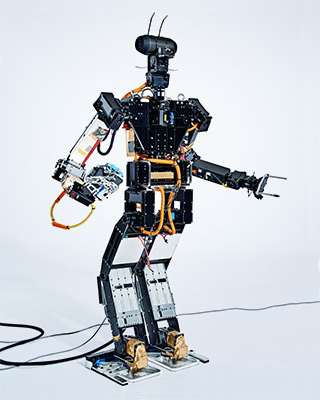They come in all shapes, sizes and have various numbers of legs. They can put out fires on ships, shimmy up construction site scaffoldings to perform dangerous inspections, safely pick their way through battlefields and enter nuclear power plants to plug radiation leaks.

Oh, and they play soccer, too. One tiny one even breakdances.
These are just some of the products from the fascinating, endlessly creative mind of UCLA’s Dennis Hong, director of legendary Robotics and Mechanisms Laboratory — “RoMeLa,” for short — and one of the world’s most acclaimed roboticists.
THIS IS NOT YOUR FATHER’S ROBOT SCIENTIST
This is one who carries a notebook and a pencil with him at all times and bases his ideas on “everywhere and everything.”
Hong traces his journey to becoming a world-famous roboticist to when he was 7 and his parents took him to see “Star Wars: Episode IV – A New Hope.” The boy was mesmerized by the iconic robots in the movie — R2-D2 and C-3PO. On the ride home, Hong announced that he was going to be a robot scientist.
That sense of wonder and joy is still with him, and is a big reason why fledgling roboticists flock to RoMeLa.
INSPIRATION DURING A STUDY BREAK
Hong also found early inspiration in observing daily life. When a graduate student, he took a study break in a park. “On the bench in front of me was a lady braiding her daughter’s hair,” Hong remembers. “Of course I’d seen braided hair before, but that was the first time I had seen the process of braiding. Three strands of hair, one goes between two. So I sketched the process. Ten years later, the U.S. Navy had a call for a proposal: They were interested in a new type of mobility robot. So I opened my sketchbook and saw the hair-braiding process. Suddenly, the strands of hair started to look like legs.”
And thus was born another one of Hong’s famous robots, the three-legged STriDER (Self-excited Tripedal Dynamic Experimental Robot).
At the lab, 20 graduate and 18 undergraduate students build and test their creations with a passion and exuberance only the truly dedicated can muster. Says RoMeLa grad student Mike Bradley, who came to UCLA from Connecticut to pursue his robot dreams, “Dr. Hong always preaches: If you’re not having fun, you’re not using all of your potential.”
DARWIN, THOR, STRIDER AND MORE
On the third floor of UCLA’s Engineering Building IV, Hong sits cross-legged in front of a seamless backdrop for a photo shoot, cradling a ridiculously adorable 18-inch-tall robot called DARwIn (officially Dynamic Anthropomorphic Robot with Intelligence, but everyone just calls it “Darwin”). It is a teaching and research robot created by Hong as open-source technology.
There are thousands of DARwIns in use around the world, helping to teach robotic locomotion and autonomous actions and generally tinkered with by roboticists everywhere. The little robot that breakdances is DARwIn’s 10-inch sibling, DARwIn Mini, which is controlled by an app.
Then there is the big boy on the block: humanoid robot THOR (for Tactical Hazardous Operations Robot). THOR, at just under 5 feet tall, is an imposing metal presence designed for disaster-relief scenarios like venturing into an irradiated nuclear plant in danger of meltdown.
In fact, some of the more practical creations that have come out of Hong’s labs don’t look like people at all (and many are the first of their kind). Some aren’t even robots, technically, like the first car that can be driven by the blind, or a snakelike robot that can climb structures (the aforementioned scaffold-shimmier). And then there’s STriDER.
“An idea itself has no value,” concludes Hong. “Only when it becomes a research program and finds its application does it become valuable. If you look at all our robots, it’s technology that will help society and make people happy — give them independence and freedom. That’s what we do.

